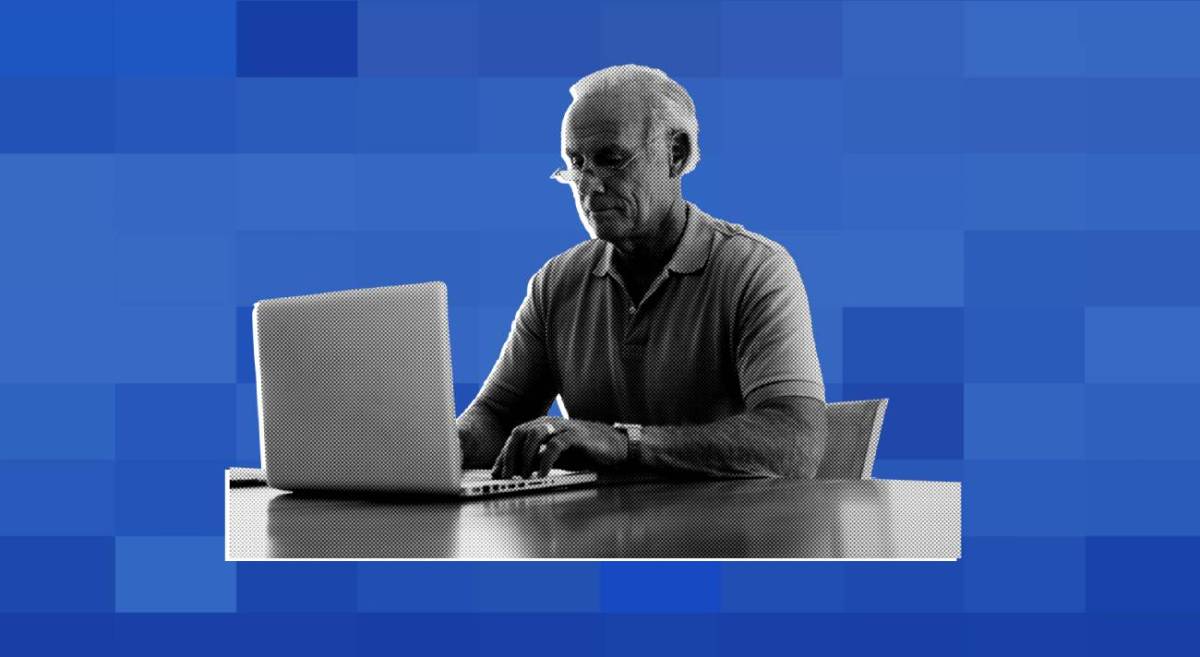Broadband expansion alone is not enough to improve access to digital services

Federal broadband expansion efforts aim to ensure that every American household has a reliable and affordable internet connection in order to learn, work and access online services. But even with a fiber connection, many challenges still stand in the way of access to the internet and digital services.
Some are unable to afford the necessary devices or internet services. Others lack a high-quality connection or digital literacy skills altogether. As a result, the relatively new field of digital equity and inclusion rose into prominence during the COVID-19 pandemic.
“The use of that infrastructure — the network, the internet — means that the digital services that the government has is engaging and now more folks can participate in it,” said Angela Siefer, executive director of the National Digital Inclusion Alliance. “One of the things that became very clear to a lot of folks during the pandemic was: Just because an infrastructure is available, doesn’t mean folks are using it.”
Some argue that digital inclusion should be included in conversations about broadband expansion and closing the digital divide. And so far, policymakers seem to be responding to the call. The historic $42.45 billion Broadband Equity Access and Deployment, or BEAD, program was a landmark 2021 federal initiative aimed at closing the digital divide that also requires recipients to create and execute digital equity plans in addition to their efforts to expand fiber connections.
Kathryn de Wit, director of the broadband initiative at the nonprofit Pew Charitable Trusts, said that over the last decade, every level of government has done work to bridge digital equity gaps. She said capital is being directed at increasing the availability of broadband connections and digital equity in terms of affordability and ensuring that community members can use those connections.
“We’ve found consistently that policy really does matter,” de Wit said. “As we look at, not only the programs that are in the process of being implemented right now, but looking ahead, the role of policy — how we establish standards, how we measure progress, how we measure success — policy is an integral part of that and to see it reflected so robustly across every level of government is remarkable and very exciting.”
But state and local governments are challenged by the absence of an official tally of how many people don’t use the internet because they cannot afford it versus those who lack digital skills or devices. Part of that problem lies with the difficulty in how to formally define and measure those gaps.
Siefer said state and local governments should be deliberate in their outreach when responding to their communities’ needs, because the barriers people face to access the internet vary by region and demographic group.
“If you have older adults that are middle income, the cost is not the barrier for them,” Siefer said. “The barrier for that individual might be digital skills and the comfort level with having to figure out something new constantly. With a low income, tech savvy household, they’ve got their digital skills, but they might not be able to afford the internet and their only device might be a mobile phone. We’ve also found that the barriers are also very much interconnected.”
‘We have the technology’
North Carolina Chief Information Officer Jim Weaver told StateScoop his state has the “best broadband program in the nation,” but admitted that many residents are still underserved.
North Carolina Gov. Roy Cooper established the state’s first office of digital equity and literacy within the broadband program in 2021 and the legislature allocated $50 million to kick start its work. Initially, the office awarded $9.9 million in grants to government entities in order to connect community members with devices and improve access to digital literacy resources in 2023.
Last spring, the office deployed another $4 million to launch the state’s first digital navigators program. Digital navigators help connect people to devices, troubleshoot connectivity issues and connect people with services like the Federal Communications Commission’s Affordable Connectivity Program, a subsidy program designed to ensure the availability of affordable, high-speed internet to households across the nation.
In November, North Carolina launched another round of grants to launch its Digital Champion program with awards being granted to organizations that “positively impact target populations,” such as low-income households, rural communities, aging residents, those with disabilities, racial or ethnic minorities or English language learners.
Weaver said he’s worried that the potential end of the ACP this spring could cause his state’s efforts to improve access to the internet and digital skills to backslide. Right now, there are around 900,000 households in North Carolina enrolled for the FCC’s internet subsidy program, but Weaver estimated that between 200,000 to 300,000 more households qualify.
Even so, Weaver admitted that it can be difficult for government leaders to develop digital services that meet residents’ needs and expectations. This challenge has caused him to flip his perspective to envision what community members need and how they would prefer to engage with government.
“People are in need of services and want help,” said Weaver, who manages his state’s digital services offerings and its broadband expansion efforts. “We have the technology to make that happen. Now, whether or not we do that is a people issue more than a technology issue, but with that said, you can’t talk about digital government unless you have connectivity.”
Digital barriers
While states can offer guidance and funding for digital equity and inclusion programs, the boots-on-the-ground efforts are really centered around local governments and community programs.
In Philadelphia, digital inclusion initiatives are housed within the city’s Public Technology and Innovation office, which also includes its digital services team. In a metropolitan area like Philadelphia, issues around connectivity are generally not because households lack a fiber connection, said Ashley Pollard, the city’s digital inclusion manager. Rather, people struggle with affordability, lack of devices and limited digital skills.
“When we talk about digital services, in our group anyway, we think about how we give residents more access particularly to government services and you generally do need some sort of online capability to do that,” said Andrew Buss, deputy CIO for the city’s Public Technology and Innovation Office.
Most of the city’s residents access the internet through a mobile phone rather than through a large-screen device, such as a laptop or desktop computer, Pollard said.
“A lot of folks are using mobile data to access the internet and might feel more comfortable with using a mobile phone,” Pollard said. “Of course, as we know, you cannot access the same services. Some forms or applications are not compatible across those devices.”
Marginalized groups of people in America disproportionately lack internet access and digital skills. A study from the Pew Research Center found that Americans with lower incomes generally have lower levels of technology adoption. Another study from Pew found that Black and Hispanic adults in the U.S. are less likely than white adults to have a traditional computer or home broadband. The Benton Institute for Broadband and Society reported this year that English remains the dominant language on the internet, posing more barriers for those with limited English-language proficiency.
In an effort to overcome those hurdles when it comes to community members’ access of the internet and other digital services, the city opted to build on existing community organizations that were already working to improve digital inclusion throughout the city, Pollard said. By doing so, the city now has a diverse group of professionals with unique skill sets to meet the needs of a wider variety of residents.
Digital solutions
The digital navigator network in Philadelphia is comprised of four organizations: Drexel University, a social services nonprofit that works primarily with southeast Asian immigrants called the Southeast Asian Mutual Assistance Association, the local United Way and a local digital equity group called the Technology Learning Collaborative.
The United Way deployed a 211 hotline that community members can call and hear about the services available to them and schedule an appointment with a digital navigator who can support their needs, whether it’s a low-cost device or affordable internet services, and some can offer digital skills training. Appointments can be held over the phone, a video call or in person.
“The navigators themselves, they really serve as digital case managers,” Pollard said.
Pollard said she measures the success of the digital navigator program by the quality of relationships built with digital navigator clients, like if a community member continues to come back for support to improve their digital skills. Other metrics include how many K-12 families were signed up for the city’s internet subsidy program and how many households signed up for the ACP through a digital navigator.
“We started to see early on was having multiple touchpoints with clients,” she said. “We would see returning clients, or we would see that a client’s needs wouldn’t necessarily be resolved in one sitting, so then that client would come back. There’s a relationship that’s built.”
‘How do you actually reach people?’
One aspect of Philadelphia’s Public Technology and Innovation Office that is unique from others is that it has a staff member dedicated to communications, outreach and engagement. The position is more proactive and seeks to spread awareness about the office’s efforts and what services are available to residents.
“Because if people are expected to use these public facing applications and services, they have to know they’re out there and they have to know the value of them,” said Buss, the deputy CIO.
“They’ve got their heads down, they’re doing their job,” added Kelsey Hubbell, Philadelphia’s communications, outreach and engagement manager. “And all of that is great, but if nobody knows about it, then how do you actually reach people? I think that’s what my role brings to the team.”
As the digital divide shrinks and more community members can reliably use government services, Buss said, the next phase is to think about digital equity and inclusion through an accessibility lens.
“Traditionally, we think about accessibility as adaptive technology, perhaps for people who don’t see as well or hear as well or use a mouse as well, for example,” Buss said. “But there’s that small accessibility as well, where we’re just focusing on good design that everyone can use, focusing on the plain English, no acronyms, information on the websites. You’re thinking about the people who don’t speak English as their first language.”
Siefer of the NDIA said that digital inclusion is an ongoing issue that will persist so long as technology evolves. And to maintain the momentum of this moment, governments need to find ways to sustain these digital inclusion and equity efforts, de Wit added.
“This is a forever issue,” Siefer said. “We will forever be figuring out how to help people get access to technology and understand how to use it, and that meets their needs. So we need long-term solutions.”

This story was featured in StateScoop Special Report: Digital Services — A StateScoop Special Report






